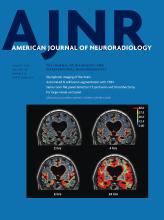We read with much interest the article by Chi et al1 in the March 2019 issue of the American Journal of Neuroradiology, “Alterations in Blood-Brain Barrier Permeability in Patients with Systemic Lupus Erythematosus.”
Reportedly, dynamic contrast-enhanced (DCE) imaging supports the hypothesis that patients with systemic lupus erythematosus have increased blood-brain barrier (BBB) permeability, specifically in the hippocampus, compared with other brain regions.1 However, some technical issues in the current study may limit its conclusions.
First, the authors stated that the pharmacokinetic 2-compartment exchange model used to calculate BBB leakage was the Tofts extended permeability model, but they provided only 2 derived parameters: the transfer constant (Ktrans) and the extravascular extracellular volume fraction (Ve), despite the fact that the Tofts extended model is supposed to provide the blood volume fraction (Vb) in addition. Vb corresponds to the volume of vessels per volume of tissue (in milliliters/100 mL of tissue or in percentages). Thus, it is likely that the model used was a Tofts-Kety model or the Tofts and Kermode model using the Olea Sphere software (Olea Medical, La Ciotat, France), which provides only Ve and Ktrans.2,3 The more complex extended Tofts model was developed to overcome some important limitations of the Tofts-Kety model, which imperfectly models DCE data and loses a significant amount of information and might not be suitable to detect subtle changes, as is the case with BBB leakage.
Second, the Ktrans parameter is a combination of tissue blood flow (Ft), corresponding to the blood flow entering and exiting a volume of tissue, and of permeability surface-area product (PS), corresponding to the flow of molecules through the capillary membranes per volume of tissue, in varying proportions. Therefore, the Ktrans method of calculation includes both perfusion- and permeability-related phenomena, leading to a possible misinterpretation of the parameters, even when accurately fitting the data. As a result, its use should be avoided when exploring permeability. Using a more complex and robust pharmacokinetic model like the 2CX, which provides 4 distinct parameters, including 2 perfusion-related parameters (Ft and Vb) and 2 permeability-related parameters (PS and Ve), would be more suitable.3,4
Third, the authors did not provide the exact duration of their DCE sequence, though this should have been a critical part of their method. Indeed, the leakage process occurs late after contrast injection, and pharmacokinetic models calculate permeability-derived parameters on the basis of a long acquisition time. A minimal duration of 10 minutes for DCE acquisitions is therefore recommended to provide accurate data, especially when observing subtle changes, as is the case in BBB leakage.3
In conclusion, one should remain cautious when interpreting these results, especially given the very low number of patients. Using a more complex and robust model such as the 2CX, as well as optimized DCE acquisitions, might substantially improve detection and understanding of BBB leakage in patients with systemic lupus erythematosus.
Footnotes
Disclosures: Julien Savatovsky—UNRELATED: Payment for Lectures Including Service on Speakers Bureaus: Medtronic, Biogen, Philips Healthcare, Sanofi, Novartis; Travel/Accommodations/Meeting Expenses Unrelated to Activities Listed: Bayer Healthcare.
- © 2019 by American Journal of Neuroradiology












